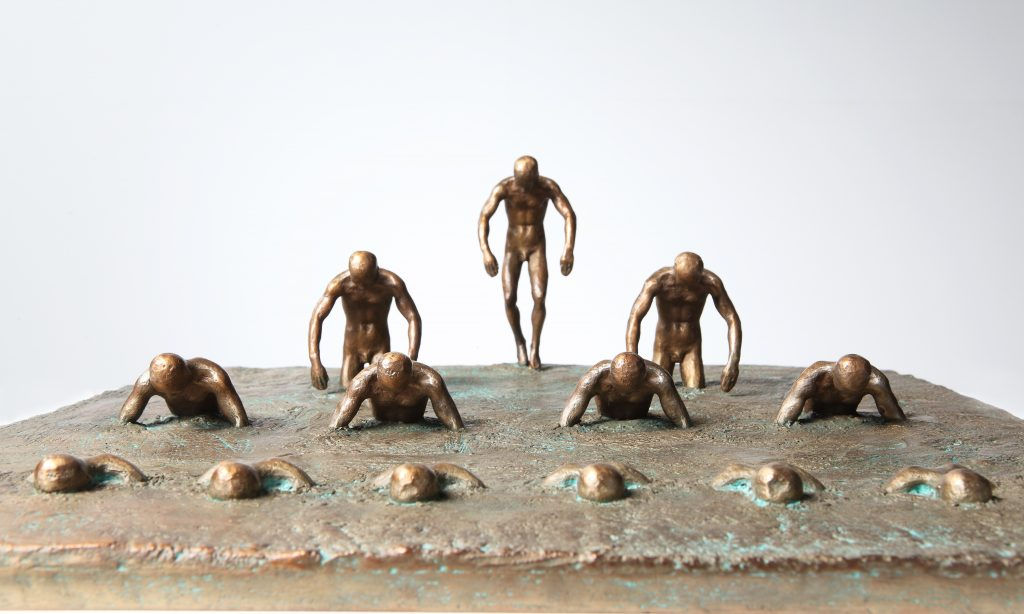Kim Young Won

Sculptor Kim's 40-year mark, maintaining a consistent orientation of realistic concrete sculpture, has been the traces of his efforts to find the human inner changes and fundamental principles by the endless encounters with the changing times.
Kim retired as professor and dean of fine arts at Hongik University 2012. He has been working as chairman of the board of the Korean Sculptors’ Association since 2008.
Kim is also known to the Korean public for the huge statue of King Sejong the Great (1397-1450) that sits in Gwanghwamun Plaza, central Seoul.
Kim Young Won who has been working on the realism with the consistent material of the human body, was evaluated as a sculptor who led to re-evaluation of the essence and value of the Korean sculpture. His works world has been changed slightly depending on the age, in the 70-80s which was passed from an agricultural society to industrial society in the transitional period his works were made in order to protest contemporary situation terribly depressed with the critical point of view and works were made on the subject of the human body of gravity and zero gravity. In the 1990's, suffering fragmentation process caused by bisection of the society, through the process of dismantling he spread out the new work world. In dismantling operations professor Kim whose body and mind are tired after that meeting with energy, achievement, and line, through a direct manifestation of consciousness, check the inside of my own, wanted sympathetic to the outside world he created a kind of performance art, sculpture line, drawing line. Including the Sao Paulo Biennial in 1994, in a number of performance Arts Festival demonstrated the type of performance he left the result left as the sculpture and drawing. Entering the 2000s, our society as IT society had been made for the transition, throughout the art we were facing upheaval. Watching these turbulent flows, he was trying to find sculpture language worthy of the 2000s in the point of view through the line experience and in the reality western civilization has brought.
For the opposite World of experience and ideas, the development of the body, he made an effort to contain the integrated alternative, interpreting it narratively on his works.
Biography
출생
1947 경남 창원
홍익대학교 조소 학사
홍익대학교 대학원 조소 석사
前홍익대학교 미술 대학 학장 한국 조각가 협회 이사장 전국미술대학교, 디자인대학교 학장 협의회 회장
수상
2008 제 7회 문신 미술상 대상 2002 김세중 기념사업회, 제16회 김세중 조각상
1989 ~ 1990 제 6-7회 선 미술상, 선화랑
1982 한국 미술협전 은상, 한국미술협회
1981 국전특선
1980제7회 한국미술대상전 우수프론티어상, 한국일보
1980 , 1981제29-30회 대한민국 미술전람회 특선, 한국문예진흥원
1980 제2회 동아미술제 동아미술상, 동아일보사
1978 , 1979제1-2회 중앙미술대전 특선
1975 제12회 목우회 공모전 문공부 장관상, 목우회
1974 제11회 목우회 공모전, 국립현대미술관장상, 목우회
주요 작품 소장처
국립현대미술관, 서울시립미술관
광화문 세종대왕상 ,동대문디자인플라자(DDP), 장춘단 공원 3.1독립기념탑
외 다수
작품세계
1.Gravity- Nongravity 중력무중력
김영원의 조각 작업은 70년대의 ‘중력 무중력’ 연작들로 시작되었습니다. 인체를 주제로 한 현실주의적 사실 조각이 주를 이룹니다. 주 개념은 현대 인간에 대한 실존적 현상을 객관적인 시각에서 서술하고자 한 것 입니다. 물질이 우선시 되는 사회에서 점차 사물화 되어가는 인간의 한계를 진솔하게 내 보임으로서 인간에 대한 깊은 통찰과 상황 인식을 통한 자기 극복의 계기를 마련하기를 염원 하였습니다. '기능적 사회에서는 정신성보다 신체성을 우선 한다' 라는 가설을 세우고 물질화로 향해 가고있는 인간군, 아무런 가치관도 없이 목적지도 없이 향락과 생존에만 급급한 비극적인 인간 현상에 대한 은유적 비판으로 이시대를 증언 하고자 하였습니다.
2. Deconstruction 해체
80년대 말의 사회적 격변 속에서 억눌렸던 자유가 폭발하고 사회 전체가 변화의 소용돌이 속에서 혼돈을 거듭할 때, 작가는 현실세계를 지켜보는 자에서 '나'를 해체하는 방향으로 선회하였습니다. 이는 스스로 다시 태어나고자 하는 절박함의 발효였습니다. 이성적 인식의 틀에서 과감히 벗어나 직관과 감성에 의한 자유롭고 새로운 작업을 위해, 알을 깨는 아픔으로 그 동안의 사실주의 조각 틀을 과감하게 해체해 버리고, 파편화 되어진 인체조각 더미에서 허무와 절망에 대면하며 “출구 없는 길”에서 새로운 길을 찾고자 방황하였습니다
3. Zen Sculpture
이 시기 작가는 명상의 쾌락에서 제작한 작품들을 대거 등장시킵니다. 주물기둥 이외에도 명상하는 자신을 시사하는 좌상, 파장을 상징하는 원반, 십진법의 숫자들, 의문의 부호 등이 나타납니다. 자아실현에 참여했던 이들의 신체표정은 전기는 물론 중간기의 해체와 복원에서 보인 험상한 모습이 아니라 하나하나가 완성된 자아를 나타내는, 이를테면 완전한 자아로서의 모습이었습니다. 작가가 이상으로서 여기는 진정한 인간상의 모범을 재현한 것 입니다.
4. Shadow of shadow
<그림자의 그림자>는 단순히 물리적 현상 이상의 영혼, 정신, 호흡, 숨결 등 비가식적 실체의 메타포이며 무의식적 자기에 대한 상징성을 갖습니다. 자아나 인간성이 매제된 그림자들은 현상만 좇아 그 안에서 또 다른 세계를 구축하고 있는데 이러한 배면에는 비실재감의 사유가 포함됩니다.
5. Cosmic Force
구도적 명상 [Spiritual Meditation] 즉, 명상 자체가 예술이 되는 예술이야 말로 예술 본연의 모습을 되찾는 신역사주의 예술입니다. 김영원 작가는 자신의 예술을 “자기 성찰과 각성의 예술”이라고 명명하고, “구도적 명상과 정신 수련을 한 선상에 놓고, 명상 자체가 예술 작업이 되는 예술”이라고 설명합니다. 서구 최고의 석학과 철학자들의 논의에서 볼 때, 우리 시대의 가장 ‘오리지널original”한 예술은 기공의 예술이라 합니다. 아방가르드 예술에서도 가장 중요하게 여기는 예술적 가치가 바로 ‘originality’ 이며 오리지널리티가 없는 창조는 진정한 창조로 보지 않습니다. 서구의 문명이 자연을 정복하고자 한 차원에서 우주/자연과 상호 적대적 관계였다면, 천지인합일의 우주/자연의 기 흐름과 공명하는 기공을 기반으로 한 김영원 작가의 예술행위는 친자연적인 신자연주의 예술을 21세기의 참 예술로 설정하고 제시하는 것 입니다.




































